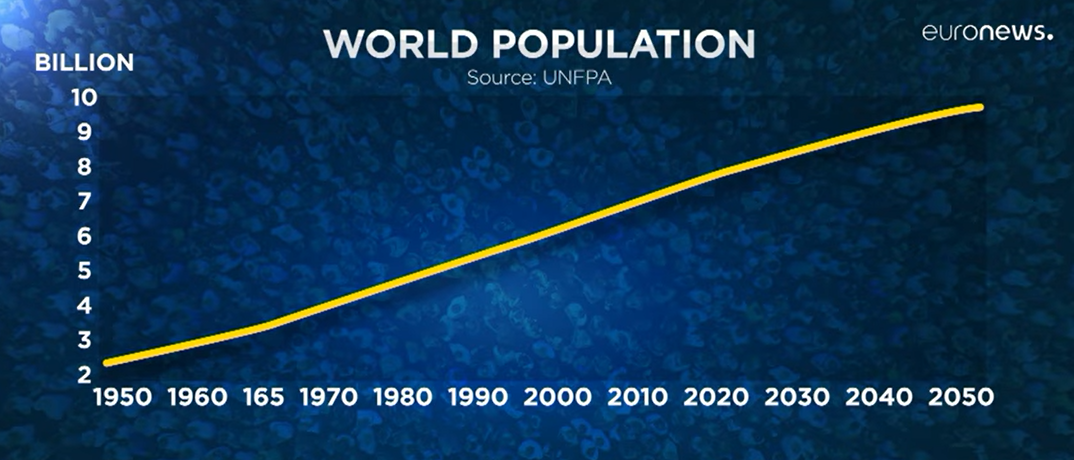The Ministry of Interior of Cyprus announced the suspension of the assessment of asylum applications for Syrians, because of pending…

The world’s population has exceeded 8 billion and by 2023 India, with a population of 1.4 billion people, will become the world’s most populous country, overtaking China.
According to official figures of the UN, in the coming decades, India will experience a rapid increase in its urban population, while its megacities are already overcrowded and face shortages in basic infrastructure.
In Mumbai, about 40% of the population lives in slums, overcrowded areas where people live in makeshift shacks and most often have no running water, electricity, or sanitation.
Global indicators hide a huge demographic diversity. More than half of the world’s population growth by 2050 will come from just 8 countries, according to the UN: the Democratic Republic of the Congo, Egypt, Ethiopia, India, Nigeria, Pakistan, the Philippines, and Tanzania.
At the end of the century, the three most populous cities in the world will be in Africa: Lagos in Nigeria, Kinshasa in DR Congo, and Dar es Salaam in Tanzania.
The population explosion causes greater problems in countries already facing poverty, as the ever-increasing birth rate, which causes rapid demographic growth, is both a symptom and a cause of slow progress in development, the UN reports.
For the UN this unprecedented growth – in 1950 there were 2.5 billion people on Earth – is the result of a progressive increase in life expectancy thanks to the advances made in the fields of public health, nutrition, personal hygiene, and medicine.
Yet demographic growth also raises great challenges for the poorest countries, where the greatest population growth is also observed.
While the Earth had less than a billion inhabitants by the 1800s, it took only 12 years for the population to grow from 7 to 8 billion.
The demographic slowdown is shown in the fact that it will take about 15 years for the population to reach 9 billion in 2037. The UN predicts that the population will reach 10.4 billion in the 2080s, before stabilizing by the end of the century.
The 8 billion mark was exceeded at the time of the UN Climate Conference (COP27) in Sharm el-Sheikh, Egypt, in which the disagreement between the richest countries (which are mainly responsible for global warming) and the poor (which are most affected and need help to cope) to significantly reduce greenhouse gas emissions was highlighted once again.
Our impact on the planet is mostly determined by our behavior than by our numbers, explained Jennifer Sciuba, a researcher at the Wilson Center.
Also read: EMSA | Sniffer drone of Greek ALTUS LSA to monitor ship emissions on Mediterranean Sea coast
READ MORE
Denmark | Extended security measures on border with Germany
Denmark extends temporary security measures on its border with Germany for another six months. Copenhagen is on…
Cyprus | Nikos Christodoulidis in Lebanon for the immigration problem
The President of the Republic, Nikos Christodoulidis, stated that he is traveling to Lebanon on Monday for a meeting with the country’s…
US Navy | First combat use of SM-3 Missiles
In a historic first, US Navy Arleigh Burke-class destroyers deployed Standard Missile-3 (SM-3) anti-missile interceptors in combat…
INIOCHOS 2024 | Allied fighters foster interoperability
NATO allied Air Forces along with regional partners come together at Andravida Air Base as Greece hosts the…
DEFEA Conference 2024 | Registration is now open
The DEFEA Conference, hosted by the international defence and security exhibition DEFEA – Defence Exhibition Athens…
Delphi Economic Forum IX | Christian Chatziminas on re-industrialization and high technology in entrepreneurship
Mr. Christian Chatziminas, Founder & CEO of THEON GROUP and President of the Hellenic Entrepreneurs Association, participated in…
Lockheed Martin | Introducing the new Mako hypersonic multi-role missile
On the sidelines of the “Sea Air Space – SAS 2024” exhibition, Lockheed Martin unveiled the new Mako hypersonic missile.
Heraklion | Aerial target washes up on beach – Taken for drone from Iran
Yesterday Sunday, intense confusion was caused on a beach in Heraklion, Crete, when an aerial target used in shooting ranges to test…






















